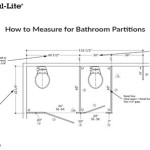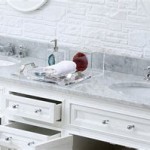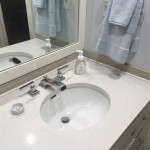How to Remove Stains From Plastic Bathroom Sinks
Plastic bathroom sinks, while durable and easy to clean, can be susceptible to staining over time. From hard water deposits to rust stains and even soap scum buildup, these unsightly marks can detract from the overall aesthetic appeal of your bathroom. Thankfully, several proven methods can effectively remove these stains, restoring your plastic sink to its original shine. This article will explore various techniques for removing stains from plastic bathroom sinks, focusing on safe and effective solutions.
Understanding the Causes of Stains
Before diving into cleaning methods, it's helpful to understand the common causes of stains in plastic bathroom sinks: *
Hard Water Deposits:
Mineral-rich water leaves behind white, chalky deposits known as hard water stains. *Rust Stains:
Iron deposits from metal objects or pipes can create rusty brown stains. *Soap Scum Buildup:
A combination of soap residue, dirt, and grime can lead to a greasy film over time. *Food and Drink Stains:
Spilled beverages, food particles, and even toothpaste can leave behind stubborn stains.Effective Cleaning Techniques for Plastic Bathroom Sinks
Here are several tried-and-true methods for removing stains from plastic bathroom sinks:
1. Baking Soda and Vinegar
This classic combination tackles multiple types of stains and is gentle on plastic surfaces. To use this method, you will need:** * Baking soda * White vinegar * Soft cloth or sponge
Prepare a paste by mixing baking soda with a small amount of water. Apply the paste to the stained area and let it sit for 10-15 minutes. Gently scrub the paste using a soft cloth or sponge. Once the paste has loosened the stain, rinse the sink thoroughly with water. If needed, follow up with a diluted vinegar solution (1 part vinegar to 2 parts water) to neutralize the baking soda and polish the surface.
2. Commercial Cleaning Products
A wide range of cleaning products specifically designed for removing stains from plastic surfaces are available at hardware and grocery stores. Look for products that contain bleach or other powerful stain-fighting agents.
Before using any commercial product, always read the manufacturer’s instructions carefully and follow them diligently to ensure safe and effective cleaning. It is also crucial to test the product in an inconspicuous area of the sink first to avoid potential damage.
3. Magic Eraser
These melamine foam erasers are known for their ability to remove stubborn stains from various surfaces, including plastic. To use a magic eraser, simply dampen it with water and gently rub the stain. Avoid excessive pressure, as it could scratch the plastic. Once the stain is gone, rinse the sink with water and dry it with a clean cloth.
4. Lemon Juice
Lemon juice is a natural, acidic cleaner that can effectively remove hard water deposits and other stains. Apply fresh lemon juice to the stained area and let it sit for 15-20 minutes. Then, use a soft cloth to scrub the area gently. Rinse the sink with water and dry completely.
5. Denture Tablets
Denture tablets are surprisingly effective for removing stains from plastic bathroom sinks, particularly those caused by hard water deposits. To use this method, simply: * Crush a denture tablet into a powder. * Mix the powder with a small amount of water to form a paste. * Apply the paste to the stained area and let it sit for 10-15 minutes. * Use a soft cloth to gently scrub the paste. * Rinse the sink with water.
6. Hydrogen Peroxide
Hydrogen peroxide is another natural stain remover that can effectively tackle rust stains and other discolorations. Apply a small amount of hydrogen peroxide to the stained area using a cotton ball or cloth. Let it sit for 15-20 minutes, then rinse the sink with water.
Preventative Measures
To minimize future stains, follow these preventative measures: *
Clean Regularly:
Routine cleaning with mild dish soap and water can help to prevent dirt and grime buildup that can cause staining. *Wiping Up Spills Promptly:
Clean up spills immediately to prevent them from setting and becoming more difficult to remove. *Using a Sink Protector:
Consider using a sink protector or sealant to minimize the chance of stains forming. *Avoiding Harsh Abrasives:
Avoid using harsh abrasives like steel wool or scouring pads, as these can scratch the plastic surface and make it more susceptible to staining. *Using Filtered Water:
If hard water is a concern, consider installing a water filter or using a pitcher filter to reduce the amount of minerals in your water. By implementing these cleaning techniques and preventative measures, you can keep your plastic bathroom sink looking sparkling clean and free from unsightly stains. Remember to always test any new cleaning product in an inconspicuous area first to avoid damaging the sink.
How To Clean Textured Fiberglass Or Plastic Shower Floor Baking Soda White Vinegar

11 Ways To Remove Stains From Plastic Foodal

How To Clean A Stained Utility Sink Within The Grove

11 Ways To Remove Stains From Plastic Foodal

How To Clean A Stained Utility Sink Within The Grove

How To Clean A White Plastic Kitchen Sink Mr Faucets

How To Remove Yellow Stains From Plastic 11 Steps With Pictures

Remove Stains From Plastic Sink Tiktok Search

Remove Stains From Plastic Sink Tiktok Search

4 Ways To Clean Plastic Wikihow
Related Posts







